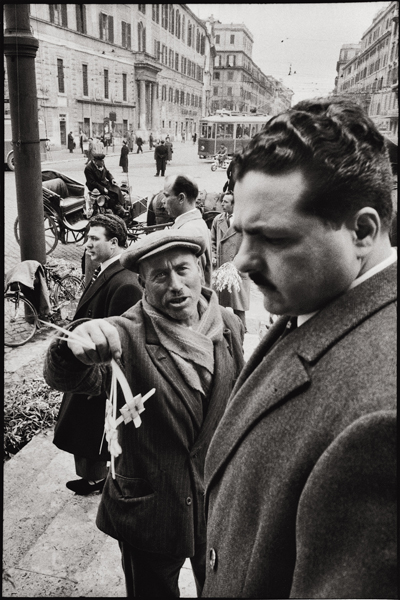Leonard Freed’s serenade to Italy

The Museo di Roma in Trastevere represents, in the city of Rome, the only museum opened to photography in the true sense of the word.
Often you can find there interesting exhibitions on American photographers, like the unforgettable one on Stephen Shore.
These kinds of shows lead the roman audience to a certain vision of photography that is less renowned in Rome, and opens new dialogue possibilities between the city and the subject of the exhibition.
This was the case of Leonard Freed, the famous Magnum photographer.
It was Magnum that starts a weird combination between art and documentary photography, and Leonard Freed was one of them who followed the idea that a snapshot can be interesting, pushing the idea of spontaneity.
It seemed that Leonard had a predilection for Italy. From there the title “Io amo l’Italia”, an exaggerated declaration of love not to be suspected.
Indeed, people came called by Freed’s celebrity, finding something maybe below the level of the photographer’s serious work.
You know, it’s from 2006 that Leonard has been dead, so we can’t absolutely blame him for this exhibition.
Maybe he even hates Italy and he was forced to come. Maybe one time, just one time, he said, to make an Italian friend happy “Iow Aemoh leh’eetalia” with an odd American accent, and the newpapers reports this quote and unfortunately the curator of the exhibition read it and he said “Ok, let’s make an exhibition on Freed’s Italian photos”
So we can’t blame Leonard, really.
We could rather blame the curator, who had to place the photographs he wants to show in the context. That would mean as the context of Italy (and that’s ok) either the modern sensibility of the watcher (and that doesn’t work).
Leonard Freed himself said “I think all the people in my pictures as characters, as in a novel”.
That’s it, Freed’s vintage shots for a modern watcher are charming like Cartier Bresson’s shots.
Indeed Leonard’s generation was the one that started that kind of spontaneous, magic in a way, photography. And that was good. But now chaps, it’s another story.
Between their times and our times were passing tons of epigones, technology progress, cheap poetry and Flickr, yeah Flickr not less. This style, as something you could show in the only serious photography museum in Rome, is over.
Among the years we have appreciated Freed’s reportages on Amsterdam in the Sixties, the Blacks in White America, his Germany and his original Wordview, so why showing us his last photos, that he probably made just for fun?
I was repeating to myself that my feeling toward Freed’s vintages were like the sixties movies I watched in Cinema Trevi (the little National Cineteque near the Fontana di Trevi). I mean the Commedia all’Italiana, the Neorealismo.
I suppose this films could appear very raw and too similar to real life to their contemporary counter parts. For a young person that watches “Divorzio all’Italiana” nowadays has a totally different reaction.
We laugh for the same gags, but there’s an added fashion. The fairy dust of time.
For Freed two thousand’s photos is exactly that situation. They are modern subjects, so no fairy dust of time. We can see them in the street everyday. In addiction, nowadays there are arrays of young photographers that shots in the same style, in case of talented youngster even better, and stuffed their flickr with that. It’s a matter of degeneration.
In this exhibition there is the old Freed’s irony, of course. We laugh for the same gag of his vintages, the same jokes in the pictures. Could be a funny stare, a opposition of characters, the fancy face of a passerby. Sometimes he plays with particular moments, sometimes with geometry and repetition, other times he has surrealistic intentions. If you want to just have fun, this is surely the most you can have with photography.
Anyhow, the impression was that Freed, close to his death, didn’t care too much to scream new. I guess that he don’t care either to exhibit his last works.
You came for the most interesting Freed, you just find an easy listening exhibition.
Naima Morelli
Inaugurazione giovedì 29 marzo ore 18
Museo di Roma in Trastevere
Piazza S. Egidio 1B Roma



